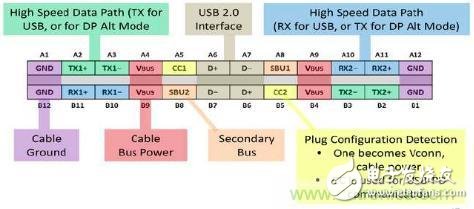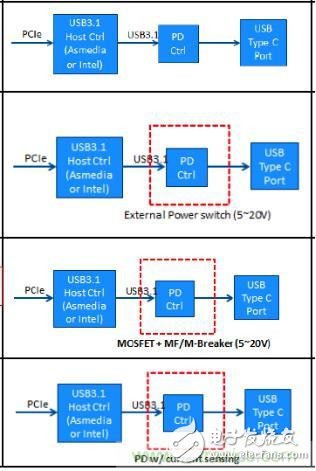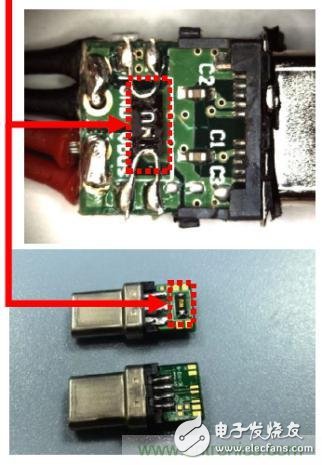In terms of performance, USB type-c is almost "universal". In terms of data transmission, it supports the USB 3.1 specification, and the data bandwidth of each channel can reach 10Gbps. At the same time, it is also the power transmission interface of electronic devices. Based on the latest USB-PD protocol, it can transmit up to 100W via USB type-c. In addition, USB Type-C supports the transmission of data and audio and video signals at the same time, which is called generalist. Finally, in the physical structure, USB Type-C supports non-directional forward and reverse insertion, and the body is also slimmer, which makes the user experience a new one. Steps. It can be seen that USB-IF is fully prepared for the upgrade of this product standard, and its "ambition" can be seen.
However, when talking about the "better" of USB Type-C, the reliability of its products can not be ignored. In use, due to the risks caused by hot plugging, short circuit, ESD, faulty equipment and user misoperation, it needs to be reliable. Circuit protection measures to resolve. Otherwise, in the user's critical eye, the grand "ambition" will inevitably break into a place.

Figure 1: USB Type-C interface function definition, structurally achieved non-directional forward and backward insertion
Circuit protection in the usual sense includes overcurrent protection and overvoltage protection. USB Type-C's overcurrent protection has four different design architectures. The first is to directly use the PD controller IC with integrated power switch. This solution has higher integration and better performance, but the cost is also higher. The second type of low cost is the "PD controller + current sensing circuit" solution, but performance is limited. The other two "PD controller + external power switch" solutions and the "PD controller + MOSFET + PTC" solution are moderately costly, and the latter is a Bourns-specific solution that achieves the best price/performance ratio and is at 5 There are several models available for developers to choose from within the -20V voltage range.

Figure 2: Four USB Type-C Overcurrent Protection Scheme Design Architecture
The overvoltage protection aspect of USB Type-C is implemented by TVS. Because USB Type-C is inserted in a non-directional structure, it has two sets of symmetric interfaces. Each group includes two sets of 10Gbps high-speed data transceiver channels (SSRX+/SSRX-, SSTX+/SSTX-), and one set is compatible with previous USB standards. The 480Mbps data channel (D+/D-) and a dedicated channel (CC+/-) for USB-PD protocol communication, so the number of channels that need to be protected is more than the previous USB interface, which requires the TVS array to appear. . For this reason, circuit protection component manufacturers have introduced a miniaturized and highly integrated solution. For example, Bourns' solution, using two 6-channel TVS array CDDFN10-0516P columns and a 4-channel TVS array CDDFN10-0524P, completes USB Type-C overvoltage protection with only three devices.

Figure 3: Bourns USB Type-C Overvoltage Protection Solution
With the promotion of USB Type-C applications, in addition to overvoltage and overcurrent protection, new protection requirements have gradually been discovered, such as over temperature protection. Due to the small size of the USB Type-C, the small pin pitch, and the maximum power of 100W, once the cable interface end is contaminated by foreign matter, it is easy to cause an increase in internal resistance, which may cause overheating or even fireworks. Therefore, the necessity of adding over-temperature protection on the cable end has gradually been recognized. The Japanese MCPC (Mobile CompuTIng PromoTIon ConsorTIum) already has provisions for over-temperature protection. I believe that the future European, American and Chinese markets will follow suit.
In terms of USB Type-C over-temperature protection, some innovative products and solutions are gradually entering the field of vision. The product manager of Shijian, a regional agent involved in the Type-C field earlier, said that Bourns has extensive experience in over-temperature protection, and its two solutions are competitive: one is to use mini-Breaker for temperature control. Device, which is a recoverable device that triggers when the temperature is abnormally high (too high), and self-recovery when the power supply is cut off or the temperature returns to a safe level; another P-TCO is a temperature-triggered solution using P-TCO The recoverable fuse is smaller and more cost-effective than the mini-Breaker. These two solutions are unique in their ability to provide more differentiated space for developers of different application needs.

Figure 4: Example of USB Type-C overtemperature protection with P-TCO, red rectangle marked P-TCO
In order to make the above protection scheme work more closely with the USB Type-C overall solution, Shijian has developed a series of complete solutions for the market demand, including USB Type-C controller integrated with Cypress integrated PD protocol, MPS high. A complete solution for energy efficient power supplies and Bourns ESD circuit protection devices. This program allows developers to get a cost-effective BOM list and make product development easier. Shijian Company further said that according to customer feedback, this integrated chip-leading solution has excellent stability and reliability, and can be widely used in Type-C Dongle, power adapter, dedicated eMark cable and other products. Especially in the middle and high-end products are very competitive.
In short, with the acceleration of the USB Type-C commercial process, its powerful functions will gradually emerge, and various creative products will emerge in an endless stream. Users enjoy the USB Type-C's powerful functionality while also taking into account reliability and security. This is a rare business opportunity for circuit protection device manufacturers.
One Digit Led Display,Two Digits Led Display,Three Digits Led Display,Four Digits Led Display
Wuxi Ark Technology Electronic Co.,Ltd. , https://www.arkledcn.com